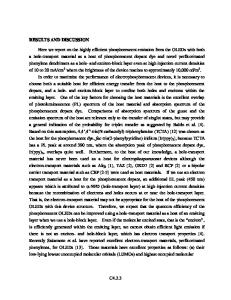Chiral Polyalkylthiophenes for Organic Light Emitting Diodes
- PDF / 113,703 Bytes
- 7 Pages / 612 x 792 pts (letter) Page_size
- 86 Downloads / 353 Views
Chiral Polyalkylthiophenes for Organic Light Emitting Diodes F. Lebon 1,2, G. Longhi 1,2, S. Abbate 1,2, M. Catellani 3, S. Luzzati 3, A. Bolognesi 3 1
Dip. Scienze Biomediche e Biotecnologie, Univ. di Brescia, Brescia, Italy Ist. Nazionale di Fisica della Materia (INFM), Brescia, Italy 3 Ist. Chimica delle Macromolecole- CNR, Milano, Italy 2
ABSTRACT Chiral polyalkylthiophenes are noncentrosymmetric organic materials which can be used both in second harmonic-generation devices and in polarized light emitting diodes. In this work we present the synthesis and the characterization of a polyalkylthiophene with a chiral center very close to the conjugated backbone: poly(3-[(S)-2-methylbutyl]thiophene) (PMBT). Circular dichroism (CD) measurements have been carried out to ascertain the chirality of these materials. The CD spectra show intense signals both in mixed solvents and in the solid state. The strong Cotton effect can be associated to a highly ordered aggregated phase whose nature is still under investigation. We also present the photo and electroluminescence characterization of single layer light emitting diode (LED) with the following configuration: ITO (Tin Indium Oxide)/PMBT/Al. INTRODUCTION Polyalkylthiophenes have been widely studied for their electrical and electronic properties in view of their potential applications [1]. The study of polythiophenes with chiral substituents has been motivated by the aim to obtain promising materials for sensors due to their possible conformational changes induced by the interaction with chemicals and/or the temperature [2]. Indeed, Meijer et al have demonstrated that polyalkythiophenes with chiral substituents exhibit, in mixed solvents large circular dichroism signals which monitor conformational changes due to small aggregates or microcrystallites with inter-chain interactions [3]. Different examples of thermochromism both in solution and in the solid state have been described in the literature [4]. Circular Dichroism (CD) spectroscopy represents one of the best tools among the chiroptical techniques to estimate the structural characteristics of these materials [5]. It has been demonstrated that the CD signals are very sensitive to the enchainment of thiophene units and that regioregularity is an important factor in the development of chiral structures [6]. Moreover optical activity is due to a chiral supramolecular organization both in solution and in the solid state [7]. This work is focused on the chiroptical and absorption/emission characterization, in solution and in the solid state, of a polyalkythiophene with a short chiral alkyl group close to the thiophene backbone: poly[3-[(S)-2-methylbutyl]thiophene] also named PMBT. We have studied the modification of the CD, UV-Visible spectra in solution of good solvent (chloroform) and in mixtures of good and bad solvent (chloroform/methanol). The same investigation was performed BB10.28.1
in the solid state on PMBT thin films with different degree of order. We present also photoluminescence (PL) and electroluminescence
Data Loading...











